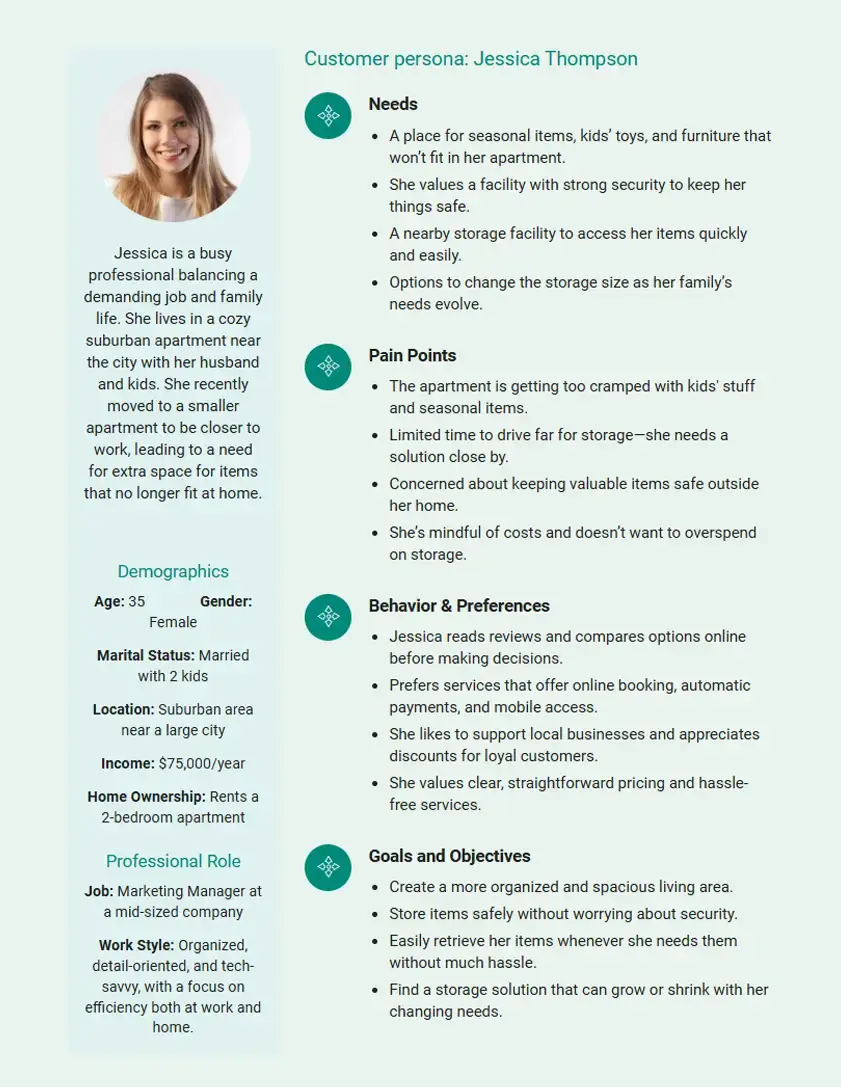Writing a professional business plan isn’t always an easy task, especially for new-age entrepreneurs. And it wasn’t any different for Ken Fischer, the owner of Units Moving and Portable Storage Company in Austin.
I recently talked to Ken about how he established a successful self storage business from scratch.
He told me about the ups and downs he faced, from finding the right location to understanding the customer needs and devising competitive prices.
From that conversation, I’ve compiled this guide to help you create your own self storage business plan as well as learn how to overcome the challenges, just like Ken did.
What is a self storage business plan?
A self storage business plan is basically a formal document that highlights your business vision, goals, and strategies to set up your own self storage space.
It not only puts your self storage business idea down on paper, but it will organize the multiple thoughts running in your mind and eventually give you a clear path to follow.
A good business plan acts as a detailed blueprint for your self storage unit as it covers everything from the types of storage units you’ll offer and how you’ll market them to cash flow projections and expected profit margins.
Why is a self storage business plan important?
Keeping a business plan for your self storage facility isn’t just a formality. But it’s an essential tool to guide your journey and make it successful. Here’s is why:
- Allows you to map out every single detail of your business, like what kind of facility you’ll run, how big it will be, and how you’ll attract customers, giving you a clear direction.
- Shows potential investors or lenders what your self storage business is all about and how you plan to make money, making it easier to get funding.
- Helps you anticipate the potential challenges or risks, like slow seasons or changes in the local economy, preparing you for bumps in the road.
Simply put, a self storage business plan can be a key to navigating the ever-evolving business landscape.
How to write a business plan for your self storage facility?
Well, writing a self storage business plan involves several actionable steps to cover all the aspects of your storage facilities. Here’s a guide:
1. Executive summary
The executive summary is a quick, concise introduction to your whole business plan.
Generally, it serves as your elevator pitch that should capture investors’ attention and convince them to invest. So, keep it short, simple, and impactful to build a strong first impression.
While drafting your plan summary, consider summarizing:
- Registered name of your self storage company
- Business concept, location, and goals
- Target market
- Unique services offerings
- Marketing plan
- Financial outlook
In short, this executive summary section briefly explains what your self storage units business is all about and what makes it special.
“The toughest part was trying to show what makes us different. Everyone says they’re ‘secure’ or ‘affordable,’ so I had to think about what really sets us apart.
After a bunch of rewrites, I focused on how our portable storage units make life easier for people—letting them pack at their own pace and even keeping the unit at their place if that’s what they need.
Plus, being in Austin meant we could serve not just city folks but also people in the surrounding areas who needed a more flexible storage option."—Ken
2. Company overview
Now, it’s time to dig into the details of your self storage business and its core values. This will provide an in-depth understanding of your business concept that every potential backer wants to know.
To plan this section, you have to answer a few questions, like:
- Who’s the self storage company owner?
- What would be the business legal structure? (LLC, sole proprietorship, partnership)
- Where is your storage company located? Why did you select that place and why would it be a good spot for your self storage business?
- What kind of storage facility are you going to open? (e.g., climate controlled storage or standard ones) And how big will it be?
- How many self storage units you’re planning to start with and what sizes you’ll offer (e.g., small units for boxes, larger ones for furniture)?
- Will you offer 24/7 access to your customers?
- What makes your storage facility different from others—your top-notch security or easy online booking system?
If applicable, describe your background history and what milestones you’ve achieved till now. Also, communicate your business’s vision and mission statement.
And lastly, don’t forget to discuss your short-term goals and long-term objectives.
“Explaining why Austin is the perfect place for our business turned out to be trickier than I thought.
I had to go beyond just saying ‘it’s a growing city’ and get into specifics, like how so many people are moving here, how the housing market is always buzzing, and how folks are looking for more convenient ways to store their stuff.
It helped me show that there’s a real need for what we’re offering, and that made the overview a lot more solid."—Ken
3. Industry and market research
Understanding the self storage industry and market is one of the crucial steps of your business planning as it lets you identify the potential customers as well as the local demand for storage.
So, you’ll need to conduct a thorough market analysis and explore the specific market niche in which your self storage business intends to operate.
Here’s a list of key elements that you must research and include in this section:
Self storage industry size & growth
Start by analyzing the current market size of the self storage industry and its growth potential for the next 5-10 years. For instance:
“The global self storage market was valued at $58.26 billion in 2023, and it’s forecasted to reach a staggering $72.15 billion by 2028.”
This will give you valuable insights into the overall demand and future opportunities within this self storage sector.
Target customers
Explore the target market and think about who’s likely to rent storage units in your area. Are they people moving into town, downsizing, or local businesses that need extra space?
Use this info to figure out what types of units you should offer and how to market to these groups. Further, recognize their needs and preferences as well as how much they’re going to pay.
If required, you may create a “customer persona” that represents your ideal client. For instance:

Market trends
Is there a growing demand for climate-controlled units because of the local weather? Are more people working from home and looking for places to store extra furniture?
After knowing these emerging trends, you can tailor your services to what people actually want.
“Doing the market analysis for Units Moving and Portable Storage in Austin was way more challenging than I thought it’d be.
I quickly realized I needed way more detail to really understand the self storage industry and the demand in the area. So, my advice?
Don’t just rely on generic industry data—dig into what’s happening in your local area, and talk to people who really know the market.
It takes more time, but it gives you a much clearer picture of where your business fits in and what customers are actually looking for."—Ken
4. Competitive analysis
Next, identify the key competitors in your area, i.e., other self storage facilities. Visit them and see what they’re doing.
How do their prices compare? What services do they offer?
Look for areas where you can do things better or fill a gap in the market. Maybe it’s your superior quality services, unique offerings, and better prices. This will give you a competitive advantage.
Furthermore, you can do an effective SWOT analysis to identify your internal strengths and weaknesses, as well as external opportunities and threats in the market.
“Most of the self storage companies had the basics covered—clean units, secure locks, standard storage stuff. But they didn’t offer much flexibility.
I realized that our edge was that we bring the storage unit straight to the customer’s door, so they don’t have to deal with traffic or multiple trips.
That’s huge in a city like Austin where getting around can be a hassle. So, I made sure to focus on how we save people time and effort compared to the traditional storage places."—Ken
5. Marketing plan
Having great self storage units won’t even matter if no one knows about them. That’s why you’ll need to discuss how you plan to attract new customers and keep your facility full.
A well-written marketing plan will provide a clear snapshot of your sales strategies as well as promotional techniques that will help you reach your target market and promote your self storage facility.
Here are some effective strategies used by popular self storage companies:
- Building an online presence through a user-friendly website
- Listing your storage business on Google My Business
- Using social media platforms like Facebook and Instagram
- Participating in community events or gatherings.
- Partnering with commercial real estate agents, moving companies, or small businesses
- Offering special discounts for long-term rentals
- Running seasonal promotions or loyalty programs
In addition to that, mention your pricing strategy that’s competitive but still allows you to cover your self storage operating expenses and make a profit.
“There are so many ways to go—Google ads, social media, partnering with local realtors—but I couldn’t afford to try everything. I had to be smart about where to put my time and money.
I focused a lot on building up our Google My Business profile and asking happy customers to leave reviews. It took some time, but it really paid off when we started showing up higher in local searches. "—Ken
6. Management team
In this section, introduce your strong management team responsible for your self storage facility’s smooth operations and decision-making.
As a self storage company owner, first you have to share a bit about yourself, covering the relevant industry experience and what skills you bring to the table.
Then, shed light on the core team members, such as business partner(s), key executives, the general manager, and the rest of the management team. Jot down their role and responsibilities, work experience, educational qualifications, and expertise.
Explain why they’re the right first for your self storage facility. Plus, showcase your organizational chart to define the hierarchical structure. For example:

Also, mention your external support systems like advisory board members who might contribute to your business’s overall growth. If your team is lacking, consider outlining your staffing requirements and training.
7. Financial plan
Now, this section is all about the numbers, giving you a complete picture of your storage facility’s financial projections for the next 5-7 years. This will even help you assess the financial viability and potential profitability.
Here’s what to include in your self storage financial plan:
- Profit and loss statement
- Cash flow statement
- Balance sheet
- Break-even analysis
Besides these critical financial statements and reports, you should also estimate how much it will cost to get your self storage business up and running.
Then, project monthly revenue and operating expenses based on occupancy rates and rental prices. Don’t forget to include a risk analysis and mitigation plan to illustrate how you’ll manage unexpected scenarios.
“Working on the break-even analysis was definitely the most frustrating part of the whole process.
I knew it was crucial to figure out when the business would start making a profit, but it wasn’t as simple as just listing expenses and hoping for the best. I had to dig into every single cost and calculate exactly how much revenue we’d need to cover them.
And with the ups and downs—like busy summer months and slower winters—I couldn’t rely on just one flat number.
I ended up running different scenarios and setting a more conservative break-even point, which gave me a much clearer and more realistic picture of what it would take to keep us afloat."—Ken
Download the self storage business plan template
Are you ready to draft your self storage business plan? But need a little extra help to get started? Don’t worry; here’s our self storage business plan template that you can download for free.
This investment-ready sample plan involves a real-life example and practical insights, showing you what a complete plan looks like. Use it as a reference point while creating your own plan, and customize it to fit your vision.
Conclusion
After exploring this comprehensive guide and a free template, you’re now well-equipped to create your own self storage business plan.
But if you ever feel stuck or need an expert-level opinion, don’t hesitate to reach out to the best business plan consultants! They’ll help you fine-tune your business plan and make sure it wins investors.
So, why wait? Start planning to grow your self storage business with confidence!
Frequently Asked Questions
What are the key components of a self storage services business plan?
The following are the key components of a self storage services business plan:
- Executive summary
- Company analysis
- Market research
- Target customers & key competitors
- Sales and marketing strategies
- Management structure
- Operations plan
- Financial projections
What are the sources of funding for a self storage facility?
For your self storage facility, explore these funding sources:
- Personal savings
- Traditional bank loans
- Private investors
- Grants and subsidies
- Business partnerships
- Crowdfunding
- Real Estate Investment Trusts(REITs)
Do I need a template for my self storage business plan?
No, it’s not mandatory. But using a template for your self storage business plan can make things a lot easier. It will give you a clear structure to follow and ensure you don’t miss any important details, saving you valuable time.
How often should I update my self storage business plan?
You should update your self storage business plan regularly, at least once a year, or more often—when there’s a significant change in your business environment. Regular updates will keep your plan relevant and help you stay focused on your goals.

